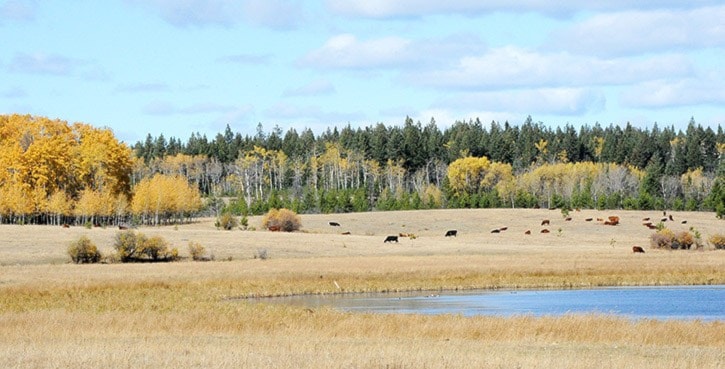Embracing the lifestyle and finding ways to diversify have been key to their success said local ranchers Corky Tucker and Ron Kaufman.
Tucker and his family raise cattle at Springhouse Ranch west of Williams Lake.
Kaufman and his family also raise cattle and grow Soda Creek Sweet Corn.
Tucker grew up on the ranch, which was established in 1859, and has been a rancher for 60 years. Four generations of Tuckers have worked at Springhouse.
Ranching is something a person has to be willing to work up to 18 hours a day, seven days a week, he said.
“You’re buying bulls instead of boats and snowmobiles. You’re putting money into feedstock, cattle, equipment, infrastructure and further development.”
Ranching is also a family business for the Tuckers. Corky and his wife have two grown children who work with them on the ranch.
One of the things that works well for Springhouse Ranch is calving in the winter.
“It’s pretty advanced,” Tucker said. “We have calving barns that are heated and we rarely lose a calf.”
With calving done in February or March, by April they are able to be outside working on irrigation and fixing fences.
Springhouse Ranch breeds and raises replacement heifers for sale all over Western Canada and the U.S.
Steer calves are sold as calves and heifer calves are kept over and sold as two-year old bred heifers.
“I’m one of the only people breeding 100 per cent Hereford,” Tucker said. “About four years ago though, we actually went over into Red Angus as well.”
Now they keep a straight Hereford herd, but are breeding half of them with Red Angus.
Buyers in places such as Colorado and Wyoming want the first cross of half Red Angus and half Hereford.
“Then they breed them back to Angus again, but Herefords put the winter hardiness in them.”
Kaufman moved to Dunlevy Ranch from East Oregon with his parents when he was nine years old, and has been managing it since 1978.
He described ranching as a satisfying way of life.
“The work is so diverse,” he said.
“It seems like you’re never doing any one thing for more than about two weeks in a row.”
They are tending to raise Black Angus more and more.
“The Black Angus Association is great at promoting Black Angus beef so we’re taking advantage of that.”
Dunlevy Ranch also runs a backgrounding operation, where they retain their calves, buy other calves to put through the winter and pasture them to sell as yearlings the next summer.
They raise long yearlings — 17 or 19 months old — so they will go into a feed lot for 100 or 150 days, a move that makes the cattle value-added, Kaufman said.
In the past Dunlevy Ranch sold cattle to the U.S., but for several years has sold mostly to Alberta.
The cattle business is cyclical, with some good years and some tough years, Kaufman said, noting Bovine Spongiform Encephalopathy (BSE) really transformed the industry during the last decade.
“Basically after BSE we missed the good part of the cycle. The Canadian consumer really helped us out, but it was international trade that impacted us.”
About the time when he began working full time at the ranch, the Kaufmans planted field corn for the cattle.
By 1980, they determined, with the microclimate at Soda Creek, that adding a u-pick sweet corn crop was a viable pursuit.
“Sweet Corn was a good move,” he said. “It’s added a stabilizing income, is growing and has become really popular.”
A couple of years ago they added u-pick vegetables, such as tomatoes, cucumbers, zucchini, peas, beans, carrots and potatoes.
Similar to the Tuckers, Dunlevy Ranch is also a family affair, with Kaufman’s son, nephew and brother all working at the ranch.
“Our dad is 89, but he still gets around, keeps an eye on things and contributes,” Kaufman said.
Tucker said the two-year Applied Sustainable Ranching program slated to begin in Williams Lake through Thompson Rivers University in 2016 is going to be fantastic.
After high school his son attended Old’s College in Alberta and graduated from the agriculture program.
“That was the closest school where he could study veterinary and feed practices, exactly the same things they are going to learn right here in Williams Lake,” Tucker said.
He noted he is excited about hosting students from the program to see first hand the things they are doing at Springhouse Ranch.
If kids can be educated locally they are more likely to stay on local ranches, Tucker said.
“Students of this program will the learn the latest ideas and technology of the industry, as well as the business side of ranching.”
Kaufman also believes in the value of education and encouraged anyone interested in ranching to pursue an education in the field of agriculture.
“World wide agriculture is a really advanced industry,” he said.
“I think we will always be relatively confined to ranching here in the Cariboo because of the climate, but there are other opportunities to diversify if you are in the right climatic zone.”
